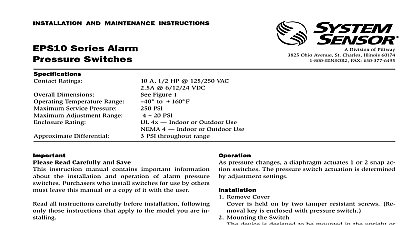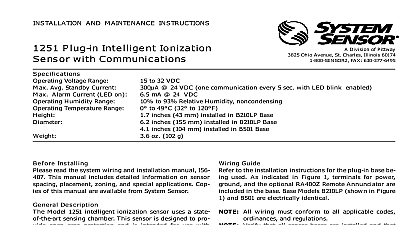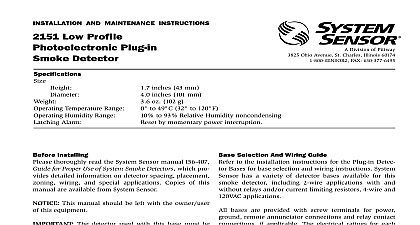System Sensor 2251 Series Install and Maint Instructions

File Preview
Click below to download for free
Click below to download for free
File Data
| Name | system-sensor-2251-series-install-and-maint-instructions-8316945207.pdf |
|---|---|
| Type | |
| Size | 659.95 KB |
| Downloads |
Text Preview
INSTALLATION AND MAINTENANCE INSTRUCTIONS Intelligent Photoelectronic Sensor Division of Pittway 3825 Ohio Avenue St Charles Illinois 60174 FAX 630 377 6495 Voltage Range Avg Standby Current Alarm Current LED on Humidity Range Temperature Range to 32 VDC 24 VDC one communication every 5 sec with LED blink enabled mA 24 VDC to 93 Relative Humidity noncondensing to 49 32 to 120 inches 43 mm installed in B210LP Base inches 155 mm installed in B210LP Base inches 104 mm installed in B501 Base oz 102 g Installing sensor must be installed in compliance with the con panel system installation manual The installation meet the requirements of the Authority Having Juris AHJ Sensors offer maximum performance when in compliance with the National Fire Protection NFPA see NFPA 72 Description 2251 is a plug in type smoke sensor that combines a sensing chamber with addressable analog The sensor transmits an analog represen of smoke density over a communication line to a panel Rotary decade switches are provided for set the sensor address Two LEDs on the sensor are con by the panel to indicate sensor status An output is for connection to an optional remote LED annun P N RA400Z 2251 requires compatible addressable communica to function properly Connect this sensor to listed control panels only Sensor recommends spacing sensors in compliance NFPA 72 In low air flow applications with smooth space sensors 30 feet apart For specific informa regarding sensor spacing placement and special ap refer to NFPA 72 or the System Sensor Guide For Use of System Smoke Detectors available at no from System Sensor P N I56 407 XX Instructions wiring must be installed in compliance with the Na Electrical Code applicable local codes and any spe requirements of the Authority Having Jurisdiction wire gauges should be used The installation wires be color coded to limit wiring mistakes and ease troubleshooting Improper connections will prevent system from responding properly in the event of a fire power from the communication line before in sensors wiring must conform to applicable local codes ordi and regulations Wire the sensor base supplied separately per the wir diagram see Figure 1 Set the desired address on the sensor address switches Figure 2 Install the sensor in to the sensor base Push the sensor the base while turning it clockwise to secure it in After all sensors have been installed apply power to the unit and activate the communication line Test the sensor s as described in the TESTING section this manual Manuals Online 1 Wiring diagram ANNUNCIATOR RETURN LOOP I covers provide limited protection against airborne particles during shipping Dust covers must be re before the sensors can sense smoke Remove sen prior to heavy remodeling or construction testing notify the proper authorities that the system undergoing maintenance and will temporarily be out of Disable the system to prevent unwanted alarms sensors must be tested after installation and periodi thereafter Testing methods must satisfy the Authority Jurisdiction AHJ Sensors offer maximum perfor when tested and maintained in compliance with 72 sensor can be tested in the following ways Functional Magnet Test P N M02 04 01 sensor can be functionally tested with a test mag The test magnet electronically simulates smoke in sensing chamber testing the sensor electronics and to the control panel Hold the test magnet in the magnet test area as shown Figure 3 The sensor should alarm the panel LEDs on the sensor are controlled by the panel to sensor status Coded signals transmitted the panel can cause the LEDs to blink latch on latch off Refer to the control panel technical docu for sensor LED status operation and ex delay to alarm Sensitivity Test Module MOD400R sensitivity test module socket is provided for checking sensor sensitivity with the MOD400R Test Module separately Use the test module with a digital analog voltmeter to check the sensor sensitivity An voltage range is stamped on the back of the Test the sensor as described in the test module Smoke Entry Aerosol Generator Gemini 501 GEMINI model 501 aerosol generator can be used smoke entry testing Set the generator to represent to 5 ft obscuration as described in the GEMINI manual Using the bowl shaped applicator apply until the panel alarms sensor that fails any of these tests should be cleaned as under CLEANING and fails after cleaning it must be replaced and returned repair testing is complete restore the system to normal op and notify is back in operation proper authorities Manuals Online 2 Rotary decade address switches 3 Test magnet position mY rTY ULE Er is recommended that the detector be removed from its base to facilitate cleaning The detector is as follows Before removing the detector notify the proper au that the smoke detector system is under maintenance and will be temporarily out of Disable the zone or system undergoing to prevent unwanted alarms the detector cover by prying away the four tabs with a small bladed screwdriver and then the cover from the base Vacuum the screen carefully without removing it If cleaning is required continue with Step 3 oth skip to Step 8 the screen assembly by pulling it straight out Figure 4 the sensing chamber cover by pulling it out the vaned chamber piece by vacuuming or out dust and particles the sensing chamber cover aligning the arrow the top with arrow on the printed circuit board replace the screen place it over the chamber as turning it until it snaps into place the cover using the test module socket and to align the cover and then gently pushing it un it locks into place the detector Test the detector as described in TESTING Reconnect disabled circuits Notify the proper authorities that the system is back 4 Sensor assembly line REMOVAL C Hl MBER D D D D D U I i dllir 1111,11mo e Manuals Online Limitations of Property Protection Smoke Detectors smoke detector is designed to activate and initiate emergency ac but will do so only when it is used in conjunction with an authorized alarm system This detector must be installed in accordance with standard 72 detectors will not work without power AC or DC powered detectors will not work if the power supply is cut off detectors will not sense fires which start where smoke does not the detectors Smoldering fires typically do not generate a lot of which is needed to drive the smoke up to the ceiling where the detector is usually located For this reason there may be large de in detecting a smoldering fire with either an ionization type detector a photoelectric type detector Either one of them may alarm only after has initiated which will generate the heat needed to drive the to the ceiling from fires in chimneys in walls on roofs or on the other side of a door s may not reach the smoke detector and alarm it A detector detect a fire developing on another level of a building quickly or at For these reasons detectors shall be located on every level and in bedroom within a building detectors have sensing limitations too Ionization detectors and detectors are required to pass fire tests of the flaming and type This is to ensure that both can detect a wide range of of fires Ionization detectors offer a broad range of fire sensing capa but they are som


